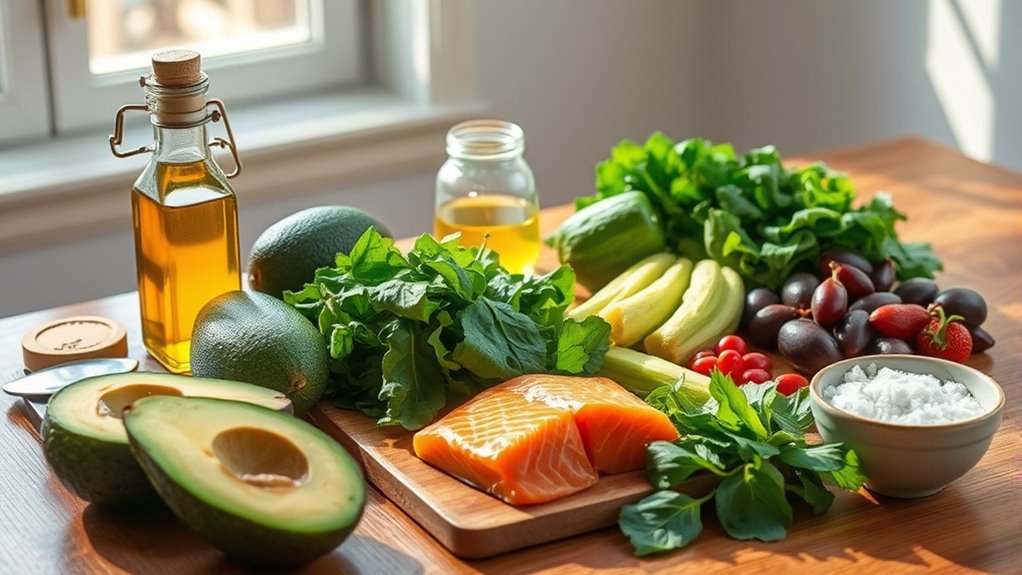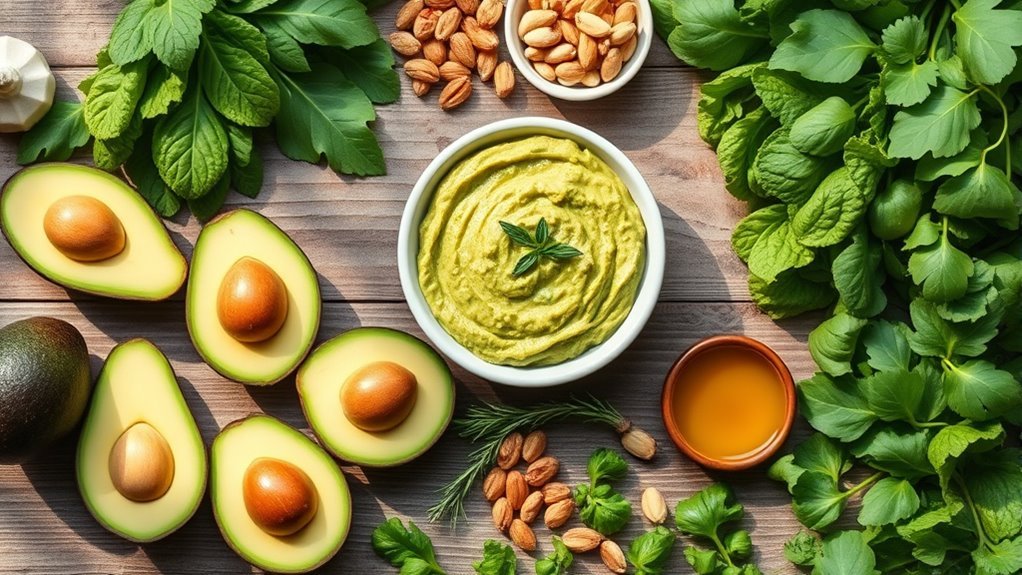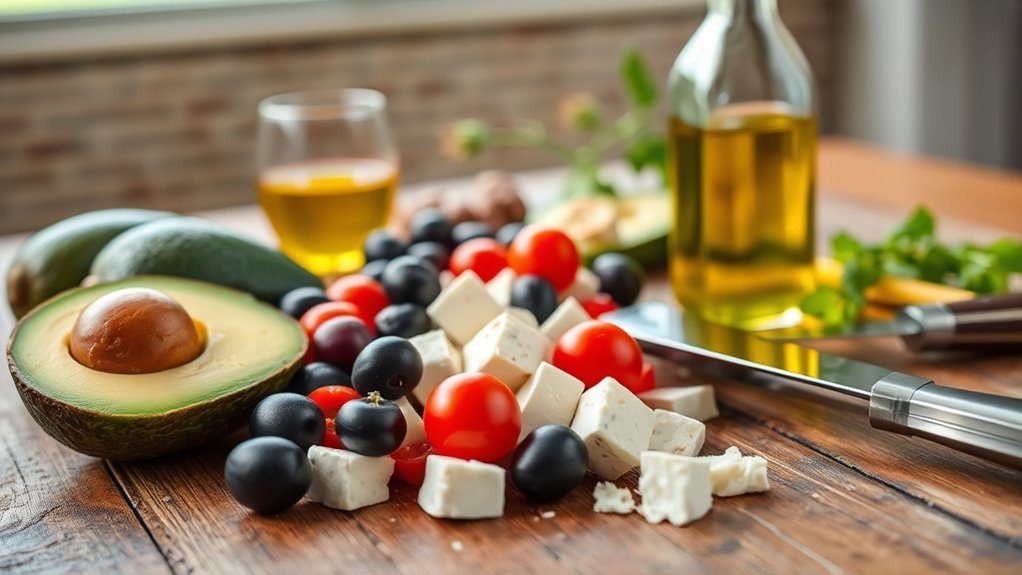To start the keto diet, you’ll need to drastically cut carbs and increase healthy fats in your meals. Focus on whole foods like avocados, nuts, and leafy greens, while incorporating healthy proteins. This shift helps your body enter ketosis, where it burns fat for energy instead of glucose. It may take time to adjust, but gradual changes can ease your adaptation. If you want to learn more about meal planning and overcoming challenges, keep exploring the details.
Understanding the Keto Diet Basics

Understanding the fundamentals of the keto diet is essential for anyone considering this low-carb, high-fat eating plan. Many people fall prey to keto misconceptions, believing it’s unsustainable or overly restrictive. In reality, the keto diet can offer flexibility and freedom when approached correctly. By focusing on whole foods like avocados, nuts, and leafy greens, you can enjoy a variety of delicious meals while entering ketosis. It’s vital to balance your macronutrients and not skimp on healthy fats, as this supports long-term keto sustainability. Remember, this diet isn’t just a fad; it’s a lifestyle shift that can empower you to take control of your health. Embrace the journey, and you’ll find success on your keto path.
The Science Behind Ketosis

To truly grasp the benefits of the keto diet, it helps to explore the science behind ketosis. This metabolic state occurs when your body shifts from using glucose to fat for energy production. During this ketosis process, your liver converts fatty acids into ketone bodies, which fuel not just your muscles but also enhance brain function.
Here are key elements of ketosis:
- Fat Adaptation: Your body becomes efficient at burning fat for energy.
- Insulin Response: Lower carbohydrate intake reduces insulin spikes, promoting fat usage.
- Dietary Changes: A high-fat, low-carb diet triggers the ketosis process.
- Nutrient Absorption: Improved absorption of nutrients supports overall health during this shift.
Understanding these factors is essential for successful keto adoption.
Benefits of the Keto Diet

The keto diet offers significant benefits, including weight loss potential and improved energy levels. By shifting your body into ketosis, you can burn fat more efficiently, leading to noticeable weight loss. Additionally, many people report feeling more energized throughout the day, thanks to the steady supply of fuel from ketones.
Weight Loss Potential
Many people turn to the keto diet for its impressive weight loss potential. By embracing this low-carb lifestyle, you can tap into powerful keto weightloss strategies that have transformed lives. Here are some key benefits:
- Increased Fat Burning: Your body shifts to burning fat for fuel, leading to significant loss.
- Appetite Suppression: High-fat intake can keep you feeling full longer, reducing cravings.
- Stable Blood Sugar: Lower carbs help stabilize insulin levels, minimizing fat storage.
- Keto Success Stories: Many individuals share inspiring transformations, showcasing the diet’s effectiveness.
With dedication and the right approach, you can experience the freedom and confidence that comes with achieving your weight loss goals through keto.
Improved Energy Levels
As you shift into a keto lifestyle, you might notice a remarkable boost in your energy levels. This increase in keto energy comes from your body adapting to burning fat instead of carbohydrates for fuel. When you’re in ketosis, your body efficiently converts fat into ketones, providing a steady energy source that helps prevent the energy crashes often associated with high-carb diets. Many people report increased stamina throughout the day, allowing them to engage in activities they love without feeling drained. By embracing this low-carb approach, you’re not just losing weight; you’re also enhancing your overall liveliness. Remember, it’s about feeling empowered and energized, enabling you to enjoy life to the fullest.
Common Myths About Keto
While you might have heard various claims about the ketogenic diet, it’s essential to separate fact from fiction. Here are some common keto misconceptions you should know:
- Keto is just another fad diet: Research shows it can be a sustainable lifestyle for many.
- You can’t eat any carbs: It’s about reducing carbs, not eliminating them completely.
- Keto causes nutrient deficiencies: With a well-planned diet, you can meet your nutritional needs.
- It’s unhealthy for your heart: Studies indicate that keto can improve heart health markers when followed properly.
Foods to Include in Your Keto Meal Plan
When planning your keto meal plan, it’s essential to focus on foods that fit the low-carb, high-fat paradigm. Incorporating healthy fats, low-carb vegetables, and protein-rich foods can help you achieve your dietary goals effectively. By choosing the right ingredients, you’ll support your body in adapting to a ketogenic lifestyle while enjoying delicious meals.
Healthy Fats Sources
Incorporating healthy fats into your keto meal plan is essential for achieving and maintaining ketosis, and you’ll want to focus on a variety of nutrient-dense sources. Here are some great options to evaluate:
- Avocado Options: Rich in monounsaturated fats, avocados are perfect for spreads and salads.
- Nut Varieties: Almonds, walnuts, and macadamia nuts offer healthy fats and protein.
- Coconut Products: Coconut oil, milk, and cream are versatile and provide medium-chain triglycerides (MCTs).
- Fatty Fish: Salmon and mackerel are excellent sources of omega-3 fatty acids.
Don’t forget about olive oil, grass-fed meats, cheese types, butter alternatives, and seed choices to round out your fat sources. Embrace these options for a satisfying and nourishing keto experience!
Low-Carb Vegetables
To thrive on a keto diet, it’s essential to include low-carb vegetables, as they provide important nutrients without hindering your carbohydrate limits. Focus on keto-friendly greens like spinach, kale, and zucchini, which are excellent low-carb options. These veggies offer significant vegetable benefits, including high nutrient density and being great fiber sources. When meal planning, consider seasonal selections to keep things fresh and exciting. Experiment with different cooking methods, such as steaming or sautéing, to enhance flavors. For grocery shopping, prioritize portion control to avoid overindulgence. Incorporating these low-carb vegetables into your meals can lead to satisfying dishes, like stir-fries or salads, while keeping your keto journey enjoyable and freeing.
Protein-Rich Foods
As you commence your keto journey, including protein-rich foods in your meal plan is essential for maintaining muscle mass and supporting overall health. Prioritize nutrient density in your protein sources to guarantee you’re fueling your body effectively. Here are four great options to take into account:
- Lean meats: Chicken, turkey, and lean cuts of beef are excellent choices.
- Seafood options: Salmon and shrimp provide healthy fats and protein.
- Dairy products: Greek yogurt and cheese offer both protein and calcium.
- Plant proteins: Think about incorporating tofu or tempeh for variety.
Additionally, don’t overlook protein shakes as a convenient way to meet your daily intake. Remember, meal timing can also play a role in optimizing your protein consumption for muscle preservation.
Foods to Avoid on a Keto Diet
While starting on a keto diet can be exciting, knowing which foods to avoid is essential for maintaining ketosis and achieving your goals. High carb foods like bread, pasta, and rice can hinder your progress, along with starchy vegetables such as potatoes and corn. Be cautious of hidden sugars in processed snacks and sugary drinks, as they can quickly add up. Unhealthy fats, including trans fats, should also be eliminated from your diet. Gluten-containing grains and legumes, like beans, can spike insulin levels, making it harder to stay in ketosis. Finally, certain fruits, particularly high-sugar varieties like bananas and grapes, should be limited. Choosing wisely empowers you to enjoy the freedom of a successful keto lifestyle!
How to Transition to a Keto Lifestyle
Shifting to a keto lifestyle can feel overwhelming, but taking it step by step makes the process manageable and enjoyable. Begin by embracing a keto mindset shift; this involves understanding your relationship with food and how it fuels your body. Next, consider these strategies:
- Gradual carb reduction: Slowly lower your carb intake to minimize withdrawal symptoms.
- Meal timing strategies: Experiment with intermittent fasting to help your body adapt to burning fat for fuel.
- Hydration: Drink plenty of water to support your metabolism and prevent keto flu.
- Support system: Engage with online communities or friends who share your goals for motivation and accountability.
Meal Planning Tips for Success
To succeed on your keto journey, effective meal planning is essential. Start by incorporating key foods that align with your dietary goals, and consider establishing a weekly meal prep routine to streamline your efforts. With a solid plan, you’ll find it easier to stay on track and enjoy delicious, satisfying meals.
Essential Foods to Include
Starting on a ketogenic journey requires a solid understanding of the essential foods that will fuel your body while keeping it in a state of ketosis. Stocking your kitchen with keto pantry essentials is vital for success. Here are some must-have ingredients to include:
- Healthy Fats: Avocado oil, olive oil, and coconut oil are great sources.
- Low-Carb Vegetables: Leafy greens, broccoli, and zucchini can add nutrients without the carbs.
- Protein Sources: Eggs, fatty fish, and grass-fed meats are excellent options.
- Nuts and Seeds: Almonds, walnuts, and chia seeds provide healthy fats and fiber.
Weekly Meal Prep Guide
While meal prepping might feel overwhelming at first, it’s one of the most effective strategies for ensuring your success on the keto diet. Start by dedicating a few hours each week to plan your meals. Choose recipes that fit your macros and make a shopping list to simplify the process. Invest in meal prep containers to keep your meals organized and fresh. Consider keto snack ideas like cheese cubes, nuts, or veggie sticks to curb cravings between meals. Batch-cook proteins and veggies, then portion them out into your containers. This way, you’ll have delicious, ready-to-eat meals on hand, giving you the freedom to enjoy your keto journey without the stress of daily cooking. Happy prepping!
Navigating Social Situations on Keto
How can you enjoy social gatherings without straying from your keto goals? It’s definitely possible with some planning and smart choices. Here are a few tips to help you navigate dining out and holiday events:
- Restaurant Choices: Opt for places with keto-friendly menus. Look for grilled meats and low-carb vegetables.
- Food Swaps: Swap high-carb sides for salads or steamed veggies during family meals.
- Party Snacks: Bring your own keto snacks to share at social gatherings, like cheese platters or veggie dips.
- Alcohol Options: Choose low-carb drinks, such as dry wines or spirits with soda water, to stay on track.
With these strategies, you can enjoy workplace lunches and gatherings while sticking to your keto journey.
Tracking Your Progress on Keto
Tracking your progress on keto can feel overwhelming at times, but it’s essential for staying motivated and adjusting your approach as needed. Start by utilizing measurement tools like a scale for weight monitoring and progress photos to visually capture your journey. Food journaling is another effective strategy; it helps you stay mindful of your meals while supporting goal setting. Consider using apps like MyFitnessPal or Cronometer for seamless progress tracking and nutrient analysis. Also, having accountability partners can provide you with the support and encouragement you need. By consistently evaluating your progress, you empower yourself to make informed choices, ensuring that your keto journey aligns with your personal freedom and health goals.


